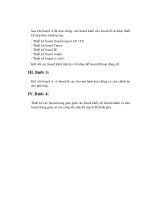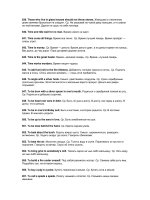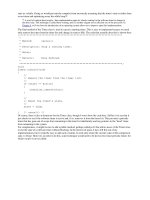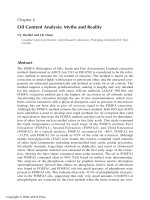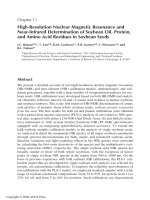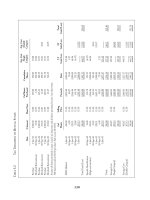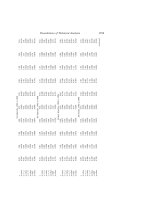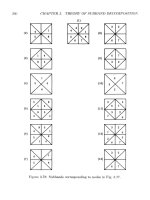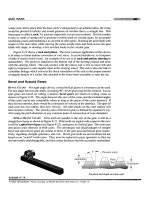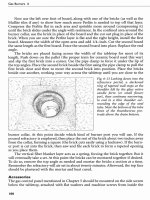Microeconomics principles and analysis phần 6 potx
Bạn đang xem bản rút gọn của tài liệu. Xem và tải ngay bản đầy đủ của tài liệu tại đây (664 KB, 66 trang )
308 CHAPTER 10. STRATEGIC BEHAVIOUR
amount that will cost a given amount k: this decision is publicly observable.
The decision on investment is crucial to the way the rest of the game works.
The following is common knowledge.
If the challenger stays out it makes a reservation pro…t level and the
incumbent makes monopoly pro…ts
M
(less the cost of investment if it
had been undertaken in stage 1).
If the incumbent concedes to the challenger then they share the market
and each gets
J
.
If the investment is not undertaken then the cost of …ghting is
F
.
If the investment is undertaken in stage 1 then it is recouped, dollar for
dollar, should a …ght occur. So, if the incumbent …ghts, it makes pro…ts
of exactly
F
, net of the investment cost.
Now consider the equilibrium. Let us focus …rst on the subgame that follows
on from a decision by the incumbent to invest (for the case where the incumbent
does not invest see Exercise 10.11). If the challenger were to enter after this
then the incumbent would …nd that it is more pro…table to …ght than concede
as long as
F
>
J
k: (10.25)
Now consider the …rst stage of the game: is it more pro…table for the incumbent
to commit the investment than just to allow the no-commitment subgame to
occur? Yes if the net pro…t to be derived from successful entry deterrence ex-
ceeds the best that the incumbent could do without committing the investment:
M
k >
J
: (10.26)
Combining the two pieces of information in (10.25) and (10.26) we get the result
that deterrence works (in the sense of having a subgame-perfect equilibrium) as
long as k has been chosen such that:
J
F
< k <
M
J
: (10.27)
In the light of condition (10.27) it is clear that, for some values of
F
,
J
and
M
, it may be impossible for the incumbent to deter entry by this method of
precommitting to investment.
There is a natural connection with the Stackelberg duopoly model. Think
of the investment as advance production costs: the …rm is seen to build up
a “war-chest” in the form of an inventory of output that can be released on
to the market. If deterrence is successful, this stored output will have to be
thrown away. However, should the challenger choose to enter, the incumbent
can unload inventory from its warehouses without further cost. Furthermore the
newcomer’s optimal output will be determined by the amount of output that
the incumbent will have stashed away and then released. We can then see that
10.6. APPLICATION: MARKET STRUCTURE 309
the overall game becomes something very close to that discussed in the leader-
follower model of section 10.6.1, but with the important di¤erence that the
rôle of the leader is n ow determined in a natural way through a common-sense
interpretation of timing in the model.
10.6.3 Another look at duopoly
In the light of the discussion of repeated games (section 10.5.3) it is useful to
reconsider the duopoly model of section 10.4.1. Applying the Folk Theorem
enables us to examine the logic in the custom and practice of a tacit cartel. The
story is the familiar one of collusion between the …rms in restricting output so as
to maintain high pro…ts; if the collusion fails then the Cournot-Nash equilibrium
will establish itself.
First we will oversimplify the problem by supposing that the two …rms have
e¤ectively a binary choice in each stage game –the y can choose one of the two
output levels as in the discussion on page 290. Again, for ease of exposition, we
take the special case of identical …rms and we use the values given in Table 10.5
as payo¤s in the stage game:
If they both choose [low], this gives the joint-pro…t maximising payo¤ to
each …rm,
J
.
If they both choose [high], gives the Cournot-Nash payo¤ to each …rm,
C
.
If one …rm defects from the collusive arrangement it can get a payo¤ .
Using the argument for equation (10.23) (see also the answer to footnote 23)
the critical value of the discount factor is
:=
J
C
So it appears that we could just carry across the argument of page 304 to the
issue of cooperative behaviour in a duopoly setting. The joint-pro…t maximising
payo¤ to the cartel could be implemented as the outcome of a subgame-perfect
equilibrium in which the strategy would involve punishing deviation from coop-
erative behaviour by switching to the Cournot-Nash output levels for ever after.
But it is important to make two qualifying remarks.
First, suppose the market is expanding over time. Let
~
(t) be a variable
that can take the value ,
J
or
C
Then it is clear that the payo¤ in the stage
game for …rm f at time t can be written
f
(t) =
~
(t) [1 + g]
t1
where g is the expected growth rate and the particular value of
~
(t) will depend
on the actions of each of the players in the stage game. The payo¤ to …rm f of
310 CHAPTER 10. STRATEGIC BEHAVIOUR
the whole repeated game is the following present value:
[1 ]
1
X
t=1
t1
f
(t)
= [1 ]
1
X
t=1
~
t1
~
(t) (10.28)
where
~
:= [1 + g]. So it is clear that we can reinterpret the discount factor as a
product of pure time preference, the probability that the game will continue and
the expected growth in the market. We can see that if the market is expected to
be growing the e¤ective discount factor will be higher and so in view of Theorem
10.3 the possibility of sustaining cooperation as a subgame-perfect equilibrium
will be enhanced.
Second, it is essential to remember that the argument is based on the simple
Prisoner’s Dilemma where the action space for the stage game just has the two
output levels. The standard Cournot model with a continuum of possible actions
intro d uce s fu rther possibilities that we have not considered in the Prisoner’s
Dilemma. In particular we can see that minimax level of pro…t for …rm f in
a Cournot oligopoly is not the Nash -equilibrium outcome,
C
. The minimax
pro…t level is zero –the other …rm(s) could set output such that the f cannot
make a pro…t (see, for example, point q
2
in Figure 10.5). However, if one were
to set output so as to ensure this outcome in every period from t + 1 to 1, this
would clearly not be a best response by any other …rm to an action by …rm f
(it is clear from the two-…rm case in Figure 10.6 that (0; q
2
) is not on the graph
of …rm 2’s reaction function); so it cannot correspond to a Nash equilibrium
to the subgame that would follow a deviation by …rm f. Everlasting minimax
punishment is not credible in this case.
29
10.7 Uncertainty
As we have seen, having precise information about the detail of how a game is
being played out is vital in shaping a rational player’s strategy –the Kriegsspiel
example on page 272 is enough to convince of that. It is also valuable to have
clear ideas about the opponents’characteristics a chess player might want to
know whether the opponent is “strong” or “weak,” the type of play that he
favours and so on.
These general remarks lead us on to the nature of the uncertainty to be
considered here. In principle we could imagine that the information available to
a player in the game is imperfect in that some details about the history of the
game are un known (who moved where at which stage?) or that it is incomplete
29
Draw a diagram similar to Figure B.33 to shaw the possible payo¤ combinati ons that
are consistent with a Nash equilibrium in in…nitely repeated subgame. Would everla sting
minimax punishment be credib le if the stage game involved Bertrand compe tition rather than
Cournot competition?
10.7. UNCERTAINTY 311
in that the player does not fully know what the consequences and payo¤s will
be for others becaus e he does not know what type of opponent he is facing (risk-
averse or risk-loving individual? high-cost or low-cost …rm?). Having created
this careful distinction we can immediately destroy it by noting that the two
versions of uncertainty can be made equivalent as far as the structure of th e game
is concerned. This is done by introducing one extra player to the game, called
“Nature.” Nature acts as an extra player by making a move that determines
the characteristics of the players; if, as is usually the case, Nature moves …rst
and the move that he/she/it makes is unknown and unobservable, then we can
see that the problem of incomplete information (missing details about types of
players) is, at a stroke, converted into one of imperfect information (missing
details about history).
10.7.1 A basic model
We focus on the speci…c case where each economic agent h has a type
h
. This
type can be taken as a simple numerical parameter; for example it could be an
index of risk aversion, an indicator of health status, a component of costs. The
type indicator is th e key to the model of uncertainty:
h
is a random variable;
each agent’s type is determined at the beginning of the game but the realisation
of
h
is only observed by agent h.
Payo¤s
The …rst thing to note is that an agent’s type may a¤ect his payo¤s (if I become
ill I may get lower level of utility from a given consumption bundle than if I
stay healthy) and so we need to modify the notation used in (10.2) to allow for
this. Accordingly, write agent h’s utility as
V
h
s
h
; [s]
h
;
h
(10.29)
where the …rst two arguments argument consists of the list of strategies – h’s
strategy and everybody else’s strategy as in expression (10.2) – and the last
argument is the type asso c iated with player h.
Conditional strategies
Given that the selection of strategy involves some sort of maximisation of payo¤
(utility), the next point we should note is that each agent’s strategy must be
conditioned on his type. So a strategy is no longer a single “button”as in the
discussion on page 283 but is, rather, a “button rule”that speci…es a particular
button to each possible value of the type
h
. Write this rule for agent h as a
function &
h
() from the set of types to the set of pure strategies S
h
. For example
if agent h can be of exactly one of two types f[healthy];[ill]g then agent h’s
button rule &
h
() will generate exactly one of two pure strategies
s
h
0
= &
h
([healthy])
312 CHAPTER 10. STRATEGIC BEHAVIOUR
Figure 10.17: Alf’s beliefs about Bill
or
s
h
1
= &
h
([ill])
according to the value of
h
realised at the beginning of the game.
Beliefs, probabilities and expected payo¤s
However, agent h does not know the types of the other agents who are players
in the game. instead he has to select a strategy based on some set of beliefs
about the others’types. Thes e beliefs are incorporated into a simple probabilistic
model: F, the joint probability distribution of types over the agents is assumed
to be common knowledge. Although it is by no means essential, from now on we
will simply assume that the typ e of each individual is just a number in [0; 1].
30
Figure 10.17 shows a stylised sketch of the idea. Here Alf, who has been re-
vealed to be of type
a
0
and who is ab out to choose [LEFT] or [RIGHT], does not
know what Bill’s type is at the moment of the decision. There are three possibil-
ities, indicated by the three points in th e information set. However, because Alf
knows the distribution of types that Bill may possess he can at least rationally
assign conditional probabilities Pr
b
1
j
a
0
, Pr
b
2
j
a
0
and Pr
b
3
j
a
0
to the
three members of the information set, given the type that has been realised for
Alf. Th ese probabilities are derived from the joint distribution F , conditional
on Alf’s own type: these are Alf’s beliefs (since the probability distribution of
types is common knowledge then he would be crazy to believe anything else).
Consider the way that this uncertainty a¤ects h’s payo¤. Each of the other
agents’strategies will be conditioned on the type which “Nature”endows them
and so, in evaluating (10.29) agent h faces the situation that
s
h
= &
h
h
(10.30)
30
This assumpti on about types i s adaptable to a wid e range of speci…c models of individual
charac teristics. Show how the two-case example used here, where the person is either of type
[healthy] or of type [ill] ca n be express ed using th e conventi on that agent h’s type
h
2 [0; 1]
if the probability of agent h being healthy is .
10.7. UNCERTAINTY 313
[s]
h
=
&
1
1
; :::; &
h1
h1
; &
h+1
h+1
; :::
(10.31)
The arguments in the functions on the right-hand side of (10.30) and (10.31) are
random variables and so the things on the left-hand side of (10.30) and (10.31)
are also random. Evaluating (10.29) with these random variables one then gets
V
h
&
1
1
; &
2
2
; :::;
h
(10.32)
as the (random) payo¤ for agent h.
In order to incorporate the random variables in (10.30)-(10.32) into a co-
herent objective function for agent h we need one further step. We assume the
standard model of utility under uncertainty that was …rst introduced in chapter
8 (page 187) – the von Neumann-Morgenstern function. This means that the
appropriate way of writing the payo¤ is in expectational terms
EV
h
s
h
; [s]
h
;
h
(10.33)
where s
h
is given by (10.30), [s]
h
is given by (10.31), E is the expectations
operator and the expectation is taken over the joint distribution of types for all
the agents.
Equilibrium
We need a further re…nement in the de…nition of equilibrium that will allow for
the typ e of uncertainty that we have just modelled. To do this note that the
game can be completely described by three objects, a pro…le of utility functions,
the corresponding list of strategy sets, and the joint probability distribution of
types:
V
1
; V
2
; :::
;
S
1
; S
2
; :::
; F (10.34)
However, we can recast the game in a way that is familiar from the discussion of
section 10.3. We could think of each agent’s “button-rule”&
h
() as a rede…ned
strategy in its own right; agent h gets utility v
h
&
h
; [&]
h
which exactly equals
(10.33) and where v
h
is just the same as in (10.2). If we use the symbol S
h
the
set of these rede…ned strategies or “button rules” for agent h Then (10.34) is
equivalent to the game
v
1
; v
2
; :::
;
S
1
; S
2
; :::
(10.35)
Comparing this with (10.3) we can see that, on this interpretation, we have a
standard game with rede…ned strategy sets for each player.
This alternative, equivalent representation of the Bayesian game enables us
to intro d uce the de…nition of equilibrium:
De…nition 10.7 A pure strategy Bayesian Nash equilibrium for (10.34) is a
pro…le of rules [&
] that is a Nash equilibrium of the game (10.35).
314 CHAPTER 10. STRATEGIC BEHAVIOUR
This de…nition means that we can just adapt (10.6) by replacing the ordinary
strategies (“buttons”) in the Nash equilibrium with the “button rules” &
h
()
where
&
h
() 2 arg max
&
h
()
v
h
&
h
() ; [&
()]
h
(10.36)
Identity
The description of this model of incomplete information may seem daunting
at …rst reading, but there is a natural intuitive way of seeing the issues here.
Recall that in chapter 8 we modelled uncertainty in competitive markets by,
e¤ectively, expanding the commodity space –n physical goods are replaced by
n$ contingent goods, where $ is the number of possible states-of-the-world
(page 203). A similar thought experiment works here. Think of the incomplete-
information case as one involving players as superhero es where the same agent
can take on a number of identities. We can then visualise a Bayesian equilibrium
as a Nash equilibrium of a game involving a larger number of players: if there
are 2 players and 2 types we can take this setup as equivalent to a game with
4 players (Batman, Superman, Bruce Wayne and Clark Kent). Each agent in a
particular identity plays so as to maximise his expected utility in that identity;
expected utility is computed using the conditional attached to the each of the
possible identities of the opponent(s); the probabilities are conditional on the
agent’s own identity. So Batman maximises Batman’s expected utility having
assigned particular probabilities that he is facing Superman or Clark Kent;
Bruce Wayne does the same with Bruce Wayne’s utility function although the
probabilities that he assigns to the (Superman, Clark Kent) identities may be
di¤erent.
This can be expressed in the following way. Use the notation E
j
h
0
to
denote conditional expectation – in this case the expectation taken over the
distribution of all agents other than h, conditional on the speci…c type value
h
0
for agent h –and write [s
]
h
for the pro…le of random variables in (10.31) at
the optimum where &
j
= &
j
, j 6= h. Then we have:
Theorem 10.4 A pro…le of decision rules [&
] is a Bayesian Nash equilibrium
for (10.34) if and only if for all h and for any
h
0
occurring with positive prob-
ability
E
V
h
&
h
h
0
; [s
]
h
j
h
0
E
V
h
s
h
; [s
]
h
j
h
0
for all s
h
2 S
h
.
So the rules given in (10.36) will maximise the expected payo¤ of every agent,
conditional on his beliefs about the other agents.
10.7.2 An application: entry again
We can illustrate the concept of a Bayesian equilibrium and outline a method
of solution using an example that ties in with the earlier discussion of strategic
10.7. UNCERTAINTY 315
issues in industrial organisation.
Figure 10.18 takes the story of section 10.6.2 a stage further. The new twist
is that the monopolist’s characteristics are not fully known by a …rm trying to
enter the industry. It is known that …rm 1, the incumbent, has the possibility of
committing to investment that might strategically deter entry: the investment
would enhance the incumbent’s market position. However the …rm may incur
either high cost or low cost in making this investment: which of the two cost
levels actually applies to …rm 1 is something unknown to …rm 2. So the game
involves …rst a preliminary move by “Nature”(player 0) that determines the cost
type, then a simultaneous move by …rm 1, choos ing whether or not to invest,
and …rm 2, choosing wh ether or not to enter. Consider the following three cases
concerning …rm 1’s circumstances and behaviour:
1. Firm 1 does not invest. If …rm 2 enters then both …rms make pro…ts
J
.
But if …rm 2 stays out then it just makes its reservation pro…t level ,
where 0 < <
J
, while …rm 1 makes monopoly pro…ts
M
.
2. Firm 1 invests and is low cost. If …rm 2 enters then …rm 1 makes pro…ts
J
<
J
but …rm 2’s pro…ts are forced right down to zero. If …rm 2 stays
out then it again gets just reservation pro…ts but …rm 1 gets enhanced
monopoly pro…ts
M
>
M
.
3. Firm 1 invests and is high cost. Story is as above, but …rm 1’s pro…ts are
reduced by an amount k, the cost di¤erence.
To make the model interesting we will assume that k is fairly large, in the
following sense:
k > max f
J
J
;
M
M
g:
In this case it is never optimal for …rm 1 to invest if it has high cost (check the
bottom right-hand part of Figure 10.18 to see this).
To …nd the equilibrium in this model we will introduce a device that we
used earlier in section 10.3.3. even though we are focusing on pure (i.e. non-
randomised) strategies let us suppose that …rm 1 and …rm 2 each consider a
randomisation between the two actions that the y can take. To do this, de…ne
the following:
31
0
is the probability that “Nature” endows …rm 1 with low cost. This
probability is common knowledge.
1
is the probability that …rm 1 chooses [INVE ST] given that its cost is
low.
2
is the probability that …rm 1 chooses [In] .
31
Write o ut the ex pressions fo r epected payo¤ for …r m 1 and for …rm 2 and verify (10.37)
and (10.39).
316 CHAPTER 10. STRATEGIC BEHAVIOUR
Figure 10.18: Entry with incomplete information
Then, writing out the expected payo¤ to …rm 1, E
1
we …nd that:
@E
1
@
1
> 0 ()
2
<
1
1 +
(10.37)
where
:=
J
J
M
M
> 0: (10.38)
Furthermore, evaluating E
2
, the expected payo¤ to …rm 2:
@E
2
@
2
> 0 ()
1
<
J
0
J
: (10.39)
The restriction on the right-hand of (10.39) only makes sense if the probability
of being low-cost is large enough, that is, if
0
1
J
: (10.40)
To …nd the equilibrium in pure strategies
32
check whether conditions (10.37)-
(10.39) can be satis…ed by probability pairs
1
;
2
equal to any of the values
(0; 0), (0; 1), (1; 0) or (1; 1). Clearly condition (10.37) rules out (0; 0) and (1; 1).
However the pair (0; 1) always satis…es the conditions, meaning that ([NOT IN-
VEST],[In]) is always a pure-strategy Nash equilibrium. Likewise, if the probabil-
ity of [LOW] is large enough that condition (10.40) holds, then ([INVEST ],[Out])
will also be a pure-strategy Nash equilibrium.
32
Will there also be a mixed-strategy equilibr ium to this game?
10.7. UNCERTAINTY 317
The method is of interest here as much as is detail of the equilibrium solu-
tions. It enables us to see a link with the solution concept that we introduced
on page 283.
10.7.3 Mixed strategies again
One of the features that emerges from the description of Bayesian Nash equilib-
rium and the example in section 10.7.2 is the use of probabilities in evaluating
payo¤s. The way that uncertainty about the type of one’s opponent is handled
in the Bayesian game appears to be very similar to the resolution of the prob-
lem arising in elementary games where there is no equilibrium in pure strategies.
The assumption that the distribution of types is common knowledge enables us
to focus on a Nash equilibrium solution that is familiar from the discussion of
mixed strategies in section 10.3.3.
In fact one can also establish that a mixed-strategy equilibrium with given
players Alf, Bill, Charlie, each of wh om randomise their play, is equivalent to
a Bayesian equilibrium in which there is a continuum of a-types all with Alf’s
preferences but slightly di¤erent types, a continuum of b-types all with Bill’s
preferences but with slightly di¤erent types, and so on, all of whom play pure
strategies.
The consequence of this is that there may be a response to those who see
strategic arguments relying on mixed strategies as arti…cial and unsatisfactory
(see page 285). Large numbers and variability in types appear to “rescue”
the situation by showing that there is an equivalent, or closely approximating
Bayesian-Nash equilibrium in pure strategies.
10.7.4 A “dynamic” approach
The discussion of uncertainty thus far has been essentially static in so far as
the sequencing of the game is concerned. But it is arguable that this misses
out one of the most important aspects of incomplete information in most games
and situations of economic con‡ict. With the passage of time each player gets
to learn something about the other players’characteristics through observation
of the other players’actions at previous stages; this information will be taken
into account in the way the game is planned and played out from then on.
In view of this it is clear that the Bayesian Nash approach outlined ab ove
only captures part of essential problem. There are two important omissions:
1. Credibility. We have already discussed the problem of credibility in con-
nection with Nash equilibria of multi-stage games involving complete infor-
mation (see pages 299 ¤). The same issue would arise here if we considered
multi-stage versions of games of incomplete information.
2. Updating. As information is generated by the actions of players this can be
used to update the probabilities used by the players in evaluating expected
utility. This is typically done by using Bayes’rule (see Appendix A, page
518).
318 CHAPTER 10. STRATEGIC BEHAVIOUR
So in order to put right the limitations of the uncertainty mod el one would
expect to combine the “perfection” involved in the analysis of subgames with
the logic of the Bayesian approach to handling uncertainty. This is exactly what
is done in the following further re…nement of equilibrium
De…nition 10.8 A perfect Bayesian equilibrium in a multi-stage game is a
collection of strategies of beliefs at each node of the game such that:
1. the strategies form a subgame-perfect equilibrium, given the beliefs;
2. the beliefs are updated from prior beliefs using Bayes’rule at every node
of the game that is reached with positive probability using the equilibrium
strategies.
The two parts of the de…nition show a nice symb iosis: the subgame-perfect
strategies at every “relevant” node make use of the set of beliefs that is the
natural one to u se at that point of the game; the beliefs are revised the light of
the information that is revealed by playing out the strategies.
However, note that the de…nition is limited in its scope. It remains silent
about what is supposed to happen to b eliefs out of equilibrium –but this issue
raises complex questions and takes us beyond the scope of the present book.
Note too, that in some cases the updating may be simple and drastic so that
the problem of incomplete information is resolved after one stage of the game.
However, despite these quali…cations, the issue of strategic interactions that in-
corporate learning is so important and so multifaceted that we shall b e devoting
all of chapter 11 to it.
10.8 Summary
Strategic behaviour is not just a new microeconomic topic but a new method
and a fresh way of looking at economic analysis. Game theory permits the
construction of an abstract framework that enables us to think through the way
economic models work in cases where the simpli…ed structure of price-taking is
inapplicable or inappropriate.
But how much should one expect from game theory? It clearly provides a
collection of important general principles for microeconomics. It also o¤ers some
truly striking results, for example the demonstration that cooperative outcomes
can be induced from sel…sh agents by the des ign of credible strategies that
involve future punishment for “antisocial” behaviour (the folk theorem). On
the other hand game theory perhaps warrants an enthusiasm that is tempered
by considerations of practicality. Game theoretic approaches do not always
give clear-cut answers but may rather point to a multiplicity of solutions and,
where they do give clear-cut answers in principle, these answers may be almost
impossible to work out in practice. To illustrate: …nding all the outcomes in
chess is a computable problem, but where is the computer that could do the
job?
10.9. READING NOTES 319
To summarise the ways in which this chapter has illustrated the contribution
of the game-theoretic approach to economic principles and to point the forward
to later chapters let us focus on three key aspects:
The nature of equilibrium. In moving to an economic environment in which
strategic issues are crucial we have had to introduce several new de…nitions
of equilibrium; in the formal literature on this subj ec t there are even more
intellectual constructions that are candidates for equilibrium concepts. Do
the subtle di¤erences between the various de…nitions matter? Each can be
defended as the correct way of modelling coherence of agents’behaviour
in a carefully speci…ed strategic setting. Each incorporates a notion of
rationality consistent with this setting. However, as the model structure
is made richer, the accompanying structure of beliefs and interlocking
behaviour can appear to be impossibly sophisticated and c omplex. The
di¢ culty for the economic modeller is, perhaps, to …nd an appropriate
location on the spectrum from total naivety to hyper-rationality (more on
this in chapter 12).
Time. The sequencing of dec isions and actions is a crucial feature of many
situations of potential economic con‡ict because it will often a¤ect the
way the underlying game is played and even the viability of the solution
concept. A modest extension of f airly simple games to more than one
period enables one to develop models that incorporate the issues of power,
induced cooperation.
Uncertainty In chapter 8 uncertainty and risk appeared in economic de-
cision making in the rôle of mechanistic chance. Here, the mechanistic
chance can be a player in the game and clear-cut results carry over from
the complete-information case, although they rest on quite strong assump-
tions about individual beliefs and understanding of the uncertain universe.
However, we can go further. The Bayesian model opens the possibility of
using the acquisition of information strategically and has implications for
how we model the economics of information. This is developed in chapter
11.
10.9 Reading notes
A good introduction is provided by Dixit and Skeath (2004), Gardner (2003),
Osborne (2004) or Rasmusen (2001); the older Gibbons (1992) still p rovides
an excellent and thorough overview of the main issues; for a more advanced
treatment Vega-Redondo (2003) is useful. The Nash equilibrium concept …rst
appeared in Nash (1951); on the appropriateness of using it as a solution conce pt
see Kreps (1990). The rationale of mixed-strategy equilibria is discussed in
Harsanyi (1973) and the argument for treating “nature”as a player in the game
is developed in Harsanyi (1967). For the history and precursors of the concept of
Nash equilibrium see Myerson (1999); on Nash equilibrium and behaviour see
320 CHAPTER 10. STRATEGIC BEHAVIOUR
Mailath (1998) and Samuelson (2002). Subgame-perfection as an equilibrium
concept is attributable to Selten (1965, 1975).
The folk theorem and variants on repeated games form a substantial liter-
ature. For an early statement in the context of oligopoly see Friedman (1971).
A key result establishing sub-game perfection in repeated games is proved in
Fudenberg and Maskin (1979).
The standard reference on industrial organisation is the thorough treatment
by Tirole (1988); the original classic contributions whose logic underlies so much
modern work are to be found in Bertrand (1883), Cournot (1838) and von
Stackelberg (1934).
10.10 Exercises
10.1 Table 10.10 is the strategic form representation of a simultaneous move
game in which strategies are actions.
s
b
1
s
b
2
s
b
3
s
a
1
0; 2 3; 1 4; 3
s
a
2
2; 4 0; 3 3; 2
s
a
3
1; 1 2; 0 2; 1
Table 10.10: Elimination and equilibrium
1. Is there a dominant strategy for either of the two agents?
2. Which strategies can always be eliminated as individually irrational?
3. Which strategies can be eliminated if it is common knowledge that both
players are rational?
4. What are the Nash equilibria in pure strategies?
10.2 Table 10.11 again represents a simultaneous move game in which strate-
gies are actions.
s
b
1
s
b
2
s
b
3
s
a
1
0; 2 2; 0 3; 1
s
a
2
2; 0 0; 2 3; 1
s
a
3
1; 3 1; 3 4; 4
Table 10.11: Pure-strategy Nash equilibria
1. Identify the best responses for each of the pl ayers a, b.
2. What are the Nash equilibria in pure strategies?
10.10. EXERCISES 321
10.3 A taxpayer has income y that should be reported in full to the tax au-
thority. There is a ‡at (proportional) tax rate on income. The reporting
technology means that that taxpayer must report income in full or zero income.
The tax authority can choose whether or not to audit the taxpayer. Each audit
costs an amount ' and if the audit uncovers under-reporting then the taxpayer
is required to pay the full amount of tax owed plus a …ne F .
1. Set the problem out as a game in strategic form where each agent (taxpayer,
tax-authority) has two pure strategies.
2. Explain why there is no simultaneous-move equilibrium in pure strategies.
3. Find the mixed-strategy equilibrium. How will the equilibrium respond to
changes in the parameters , ' and F ?
10.4 Take the “battle-of-the-sexes” game of footnote 3 (the strategic form is
given in Table B.1 on page 562).
1. Show that, in addition to the pure strategy, Nash equilibria there is also a
mixed strategy equilibrium.
2. Construct the payo¤-possibility frontier (as in Figure B.33 on page 566).
Why is the interpretation of this frontier in the battle-of-the-sexes context
rather unusual in comparison with the Cournot-oligopoly case?
3. Show that the mixed-strategy equilibrium lies strictly inside the frontier.
4. Suppose the two players adopt the same randomisation device, observable
by both of them: they know that the speci…ed random variable takes the
value 1 with probability and 2 with probability 1 ; they agree to play
s
a
1
; s
b
1
with probability and
s
a
2
; s
b
2
with probability 1; show that this
correlated mixed strategy always produces a payo¤ on the frontier.
10.5 Rework Exercise 10.4 for the case of the game in Table 10.3 (this is
commonly known as the Chicken game).
10.6 Consider the three-person game depicted in Figure 10.19 where strategies
are actions. For each strategy combination, the column of …gures in parentheses
denotes the payo¤ s to Alf, Bill and Charlie, respectively. (Fudenberg and Tirole
1991, page 55)
1. For the simultaneous-move game shown in Figure 10.19 show that there
is a unique pure-strategy Nash equilibrium.
2. Suppose the game is changed. Alf and Bill agree to coordinate their ac-
tions by tossing a coin and playing [LEFT],[left] if heads comes up and
[RIGHT],[right] if tails comes up. Charlie is not told the outcome of the
spin of the coin before making his move. What is Charlie’s best response?
Compare your answer to part 1.
322 CHAPTER 10. STRATEGIC BEHAVIOUR
Figure 10.19: Bene…ts of restricting information
3. Now take the version of part 2 but suppose that Charlie knows the out-
come of the coin toss before making his choice. What is his best response?
Compare your answer to parts 1 and 2. Does this mean that restricting
information can be socially bene…cial?
10.7 Consider a duopoly with identical …rms. The cost function for …rm f is
C
0
+ cq
f
; f = 1; 2:
The inverse demand function is
0
q
where C
0
, c,
0
and are all positive numbers and total output is given by
q = q
1
+ q
2
.
1. Find the isopro…t contour and the reaction function for …rm 2.
2. Find the Cournot-Nash equilibrium for the industry and illustrate it in
q
1
; q
2
-space.
3. Find the joint-pro…t maximising solution for the industry and illustrate it
on the same diagram.
4. If …rm 1 acts as leader and …rm 2 as a follower …nd the Stackelberg solu-
tion.
10.10. EXERCISES 323
5. Draw the set of payo¤ possibilities and plot the payo¤s for cases 2-4 and
for the case where there is a monopoly.
10.8 An oligopoly contains N identical …rms. The cost function is convex in
output. Show that if the …rms act as Cournot competitors then as N increases
the market price will approach the competitive price.
10.9 Two identical …rms consider entering a new market; setting up in the
new market incurs a once-for-all cost k > 0; production involves constant mar-
ginal cost c. If both …rms enter the market Bertrand competition then takes
place afterwards. If the …rms make their entry decision sequentially, what is the
equilibrium?
10.10 There is a cake of size 1 to be divided between Alf and Bill. In period
t = 1 Alf o¤ers player Bill a share: Bill may accept now (in which case the
game ends), or reject. If Bill rejects then, in period t = 2 Alf again makes an
o¤er, which Bill can accept (game ends) or reject. If Bill rejects, the game ends
one period later with exogenously …xed payo¤s of to Alf and 1 to Bill.
Assume that Alf and Bill’s payo¤s are linear in cake and that both persons have
the same, time-invariant discount factor < 1.
1. What is the backwards induction outcome in the two-period model?
2. How does the answer change if the time horizon increases but is …nite?
3. What would happen if the horizon were in…nite? (Rubinstein 1982, Ståhl
1972, Sutton 1986)
10.11 Take the game that begins at the node marked “*”in Figure 10.16 (page
307).
1. Show that if
M
>
J
>
F
then the incumbent …rm will always concede
to a challenger.
2. Now suppose that the incumbent operates a chain of N stores, each in a
separate location. It faces a challenge to each of the N stores: in each
location there is a …rm that would like to enter the local market). The
challenges take place sequentially, location by location; at each point the
potential entrant knows the outcomes of all previous challenges. The pay-
o¤s in each location are as in part 1 and the incumbent’s overall payo¤ is
the undiscounted sum of the payo¤s over all locations. Show that, however
large N is, all the challengers will enter and the incumbent never …ghts
(Selten 1978).
10.12 In a monopolistic industry …rm 1, the incumbent, is considering whether
to install extra capacity in order to deter the potential entry of …rm 2. Marginal
capacity installation costs, and marginal production costs (for production in ex-
cess of capacity) are equal and constant. Excess capacity cannot be sold. The
324 CHAPTER 10. STRATEGIC BEHAVIOUR
potential entrant incurs a …xed cost k in the event of entry.(Dixit 1980, Spence
1977)
1. Let q
1
be the incumbent’s output level for which the potential entrant’s best
response yields zero pro…ts for the entrant. Suppose q
1
6= q
M
, where q
M
is
…rm 1’s output if its monopolistic position is unassailable (i.e. if entry-
deterrence is inevitable). Show that this implies that market demand must
be nonlinear.
2. In the case where entry deterrence is possible but not inevitable, show
that if q
1
S
> q
1
, then it is more pro…table for …rm 1 to deter entry than
to accommodate the challenger, where q
1
S
is …rm 1’s output level at the
Stackelberg solution
10.13 Two …rms in a duopolistic industry have constant and equal marginal
costs c and face market demand schedule given by p = k q where k > c and q
is total output
1. What would be the solution to the Bertrand price setting game?
2. Compute the joint-pro…t maximising solution for this industry.
3. Consider an in…nitely repeated game based on the Bertrand stage game
when both …rms have the discount factor < 1. What trigger strategy,
based on punishment levels p = c; will generate the outcome in part 2?
For what values of do these trigger strategies constitute a subgame perfect
Nash equilibrium?
10.14 Consider a market with a very large number of consumers in which a
…rm faces a …xed cost of entry F . In period 0, N …rms enter and in period 1 each
…rm chooses the quality of its product to be High, which costs c > 0, or Low,
which costs 0. Consumers choose which …rms to buy from, choosing randomly
if they are indi¤erent. Only after purchasing the commodity can consumers
observe the quality. In subsequent time periods the stage game just described is
repeated inde…nitely. The market demand function is given by
q =
8
<
:
'(p) if quality is believed to beHigh
0 otherwise
where ' () is a strictly decreasing function and p is the price of the commodity.
The discount rate is zero.
1. Specify a trigger strategy for consumers which induces …rms always to
choose high quality. Hence determine the subgame-perfect equilibrium.
What price will be charged in equilibrium?
2. What is the equilibrium number of …rms, and each …rm’s output level in
a long-run equilibrium with free entry and exit?
10.10. EXERCISES 325
3. What would happen if F = 0?
10.15 In a duopoly both …rms have constant marginal cost. It is common
knowledge that this is 1 for …rm 1 and that for …rm 2 it is either
3
4
or 1
1
4
. It is
common knowledge that …rm 1 believes that …rm 2 is low cost with probability
1
2
. The inverse demand function is
2 q
where q is total output. The …rms choose output simultaneously. What is the
equilibrium in pure strategies?
326 CHAPTER 10. STRATEGIC BEHAVIOUR
Chapter 11
Information
As we know,
There are known knowns.
There are things we know we know.
We also know
There are known unknowns.
That is to say
We know there are some things
We do not know.
But there are also unknown unknowns,
The ones we don’t know
We don’t know.
— Donald Rumsfeld. Feb. 12, 2002, Department of Defense news
brie…ng.
11.1 Introduction
We have already seen that economics can do a lot more than just talk about the
“known knowns.”The economics of information builds on elementary reasoning
about “known unknowns”and incorporates elements of both exogenous uncer-
tainty –blind chance –and endogenous uncertainty –the actions and reactions
of others; it has connections with previous discussions both of uncertainty and
risk (chapter 8) and of the economics of strategic behaviour (chapter 10).
In principle uncertainty can be incorporated into models of strategic behav-
iour in a variety of interesting ways, some of which were treated in chapter 10.
Here we focus on just one important class of problem that can be categorised in
terms of Bayesian games and we focus on perfect Bayesian equilibrium: but it
327
328 CHAPTER 11. INFORMATION
type of hidden information
…rst move by characteristics actions
uninformed adverse selection moral hazard
informed signalling –
Table 11.1: Types of incentive problem
is a rich class and the equilibrium behaviour can be readily interpreted in terms
of microeconomic intuition.
The structure of the problem is closely related to the issue of timing in
models of strategic behaviour. We imagine an economic relationship between
two economic actors or players, one of whom has some information that is key to
the economic relationship that the other does not possess. The central questions
concern (i) the nature of the hidden information and (ii) which of the players –
the well informed or the uninformed –gets to make the …rst move.
The three main paradigms are highlighted in Table 11.1 –they are discussed
separately in the three main sections of this chapter, 11.2 to 11.4. However,
before moving on to these two comments should be made on the simple clas-
si…cation in this table. First, the bottom right cell remains blank because the
situation where the uninformed player cannot observe an action of the player
who draws up the contract is not intrinsically very interesting. Second, the term
“uninformed” is a slight misnomer. Quite a lot of information about charac-
teristics and actions is common knowledge in these models, indeed it has to b e
so for the economic problem to be well de…ned. In order to obtain and analyse
clear-cut principles to apply to the behaviour of economic agents we need to be
clear about the precise form of the distribution of the relevant random variables
that are used to represent the lack of speci…c information that characterises
many economic problems. We need to impose a rigid structure on the “known
unknowns”in the Rumsfeldian terminology.
11.2 Hidden characteristics: adverse selection
We begin with the problem that information about some crucial parameter in
an economic transaction –personal tastes or individual ability, let us say –is
known to one party in the transaction but not to the other. We will treat this
…rst in the context of a monopolist confronted by heterogeneous consumers.
The reason for starting like this is that it is fairly easy to see exactly how and
why the economic mechanism works in this case and to deduce the principles
underlying the solution. Although we work out the results in the context of a
highly simpli…ed model the lessons are fairly general and can be extended to
quite complex situations. Later we move on from monopoly to cases where there
are many partially-informed …rms competing for customers – see subsections
11.2.5 and 11.2.6.
11.2. HIDDEN CHARACTERISTICS: ADVERSE SELECTION 329
11.2.1 Information and monopoly power
In a two-good model suppose a monopolistic …rm produces good 1 from good
2 at constant marginal cost c. The monopolist is free to set whatever fees or
charges for good 1 that it wishes; the nature of good 1 is such that it is possible
to prevent resale of the goo d.
The analysis of the monopolist’s problem requires speci…cation of a fee sched-
ule F that gives the total amount to be paid F (x
1
) by a customer who consumes
a quantity x
1
of good 1. For example Figure 11.1 depicts three alternative forms
that the fee schedule could take:
1. The simplest case with a uniform price p:
F (x) = px
1
:
2. The two-part tari¤ comprising an entry fee F
0
(required to get access to
the market) and a …xed price for the marginal unit of good 1:
F (x) = F
0
+ px
1
if x
1
> 0:
3. The multi-part tari¤ that can take a huge range of forms. One example is
F (x) = F
0
+ p
0
x
1
if 0 < x
1
x
1
= F
0
+ p
0
x
1
+ p
00
[x
1
x
1
] if x
1
> x
1
:
The …rm obviously needs to choose what sort of fee schedule is appropriate
in order to maximise pro…ts – not just what values parameters such as p and
F
0
should take. But there is a further problem to be considered: in order to
maximise pro…ts would the …rm want to distinguish between di¤erent groups of
customers when setting its fee? If so, how should the …rm take account of this
potential di¢ culty in designing its fee structure?
We proceed by …rst setting out the problem in the special cases where infor-
mational problems do not arise (sections 11.2.2 and 11.2.3); then we look at the
case where an informational problem arises and examine how to solve it (section
11.2.4). Although we will only consider a s impli…ed f orm of the informational
problem, the principles that will be established are valid for a more general
structure.
11.2.2 One customer type
To start with we shall in e¤ect revisit the modelling of section 3.6 in chapter 3
but now with an explicit analysis of the welfare of the consumer; furthermore
we do not assume in advance the type of charging scheme that will be adopted –
that is going to emerge from the …rm’s optimisation problem. A typical customer
has income y (denominated in units of go od 2) and preferences represented by
the utility function
U (x
1
; x
2
) = (x
1
) + x
2
(11.1)
330 CHAPTER 11. INFORMATION
Figure 11.1: Alternative fee schedules
where (0) = 0,
x
(x) > 0,
xx
(x) < 0 (subscripts on denote …rst and
second derivatives, following our usual convention); the indi¤erence curves for
this utility f unc tion are illustrated in Figure 11.2. Notice that the form (11.1)
implies that the demand for good 1 has a zero income e¤ect:
1
a convenient
feature of such a utility function is that for changes in the fee schedule for good
1 there is a unique measure of consumer welfare: the consumer’s surplus is equal
to the compensating variation and to the equivalent variation –see page 92 in
chapter 4.
The …rm sets a fee schedule F () as discussed on page 330: from the con-
sumer’s point of view this fee schedule simply determines his budget constraint
–just take a particular F () graph from Figure 11.1 and insert it, upside-down,
into the standard diagram of the consumer’s choices in commodity space (see
for example Figure 11.2 below). So the individual’s consumption of goo d 2 is
x
2
=
8
<
:
y F (x
1
) if x
1
> 0
y if x
1
= 0
9
=
;
and utility is given by
U (x
1
; x
2
) =
8
<
:
y + (x
1
) F (x
1
) if x
1
> 0
y if x
1
= 0
9
=
;
: (11.2)
1
Explain why this is so.
11.2. HIDDEN CHARACTERISTICS: ADVERSE SELECTION 331
The consumer purchases good 1 under a given fee schedule F () if and only if
the top line in (11.2) is at least as great as the bottom line, in other words as
long as the following participation constraint is satis…ed:
U (x
1
; x
2
) U (0; y) (11.3)
This constraint (11.3) is equivalent to the condition
(x
1
) F (x
1
) 0 (11.4)
It is clear from (11.2) that – in the case where “>”holds in (11.4) –if the fee
schedule F () were to be shifted upwards, then the consumer’s utility would
decrease. Increasing the fee transfers consumer’s surplus to the monop olist’s
pro…ts.
The FOC for an internal solution to the consumer’s maximisation problem
is given by:
x
(x
1
) = p (x
1
) (11.5)
where p () is the …rst derivative of F () –the unit price of a marginal amount
of good 1. This has the interpretation “marginal willingness to pay = price at
the margin.”The solution to (11.10) can be written implicitly as
x
1
(F ) =
8
<
:
' (p (x
1
)) if F (x
1
) (x
1
)
0 otherwise
9
=
;
: (11.6)
where ' () is the inverse of the function
x
().
The …rm has freedom to choose whatever the fee schedule it wants subject
to the consumer’s response speci…ed in (11.6). So its optimisation problem is to
choose F () to maximise
F (x
1
) cx
1
(11.7)
where x
1
is given by (11.6).
First note that if the case “<” were to hold in (11.4) then pro…ts could be
increased by shifting F () upwards. So at the …rm’s pro…t-maximising solution
the case “=”in (11.4) must hold; in other words we have
F (x
1
) = (x
1
) : (11.8)
Therefore the problem (11.7) can be written:
max (x
1
) cx
1
subject to (11.6). Because the …rm can arbitrarily manipulate the fee schedule
it can e¤ectively choose the amount x
1
that will be bought by the consumer,
subject to the participation constraint. The FOC for the …rm’s problem is
therefore
x
(x
1
) c = 0 (11.9)
332 CHAPTER 11. INFORMATION
a high-valuation customer typ e
b low-valuation customer type
taste parameter
() utility of go od 1
y individual income
c marginal cost for good 1
proportion of high-valuation types
F () fee schedule
Table 11.2: Adverse selection: Elements of the problem
or equivalently
p (x
1
) = c; (11.10)
the price of the marginal unit is everywhere equal to marginal cost, a constant
in this model.
Therefore the pro…t-maximising allocation can be implemented by o¤ering
the individual a contract consisting of the simple fee schedule
F (x
1
) = F
0
+ px
1
(11.11)
where p = c and F
0
is a …xed charge or “entry fee”chosen such that (11.8) is
satis…ed. Given that (11.5) characterises the individual customer’s reaction to
the fee schedule o¤ered by the …rm, using (11.8), (11.6) and (11.11) we …nd
F
0
= (' (c)) c' (c) : (11.12)
The resulting charging scheme is a two-part tari¤s ummarised by the pair (p; F
0
),
…rst introdu ce d in section 3.6.3 on page 61. We see now that it involves com-
plete exploitation of the consumer (no consumer surplus is left): the individual
consumer is forced to his reservation utility level := U(0; y). This is illus-
trated in Figure 11.2: the left-hand side shows the fee schedule set by the …rm,
where the intercept is F
0
and the slope is simply marginal cost; the right-hand
side shows the impact of the fee schedule on the consumer with income y; the
reservation indi¤erence curve has been emphasised a little and the attainable
set –a triangle with a “spike”on top –has been shaded in; the boundary of the
attainable set is just the fee schedule from the left-hand panel, ‡ipped vertically.
However, although it is exploitative, the fee schedule is e¢ cient: unlike a simple
monopolistic pricing strategy (such as those outlined in sections 3.6.1 and 3.6.2
of chapter 3), the fee structure given in (11.11) and (11.12) does not force prices
above marginal cost.
One …nal note: the two-part-tari¤ (p; F
0
) is not the only way of implementing
the pro…t-maximising outcome. The …rm could, f or example, just o¤er a single
“take-it-or-leave-it”contract which o¤ers an amount x
1
:= ' (c) in exchange for
a given payment of
F := (x
1
).
